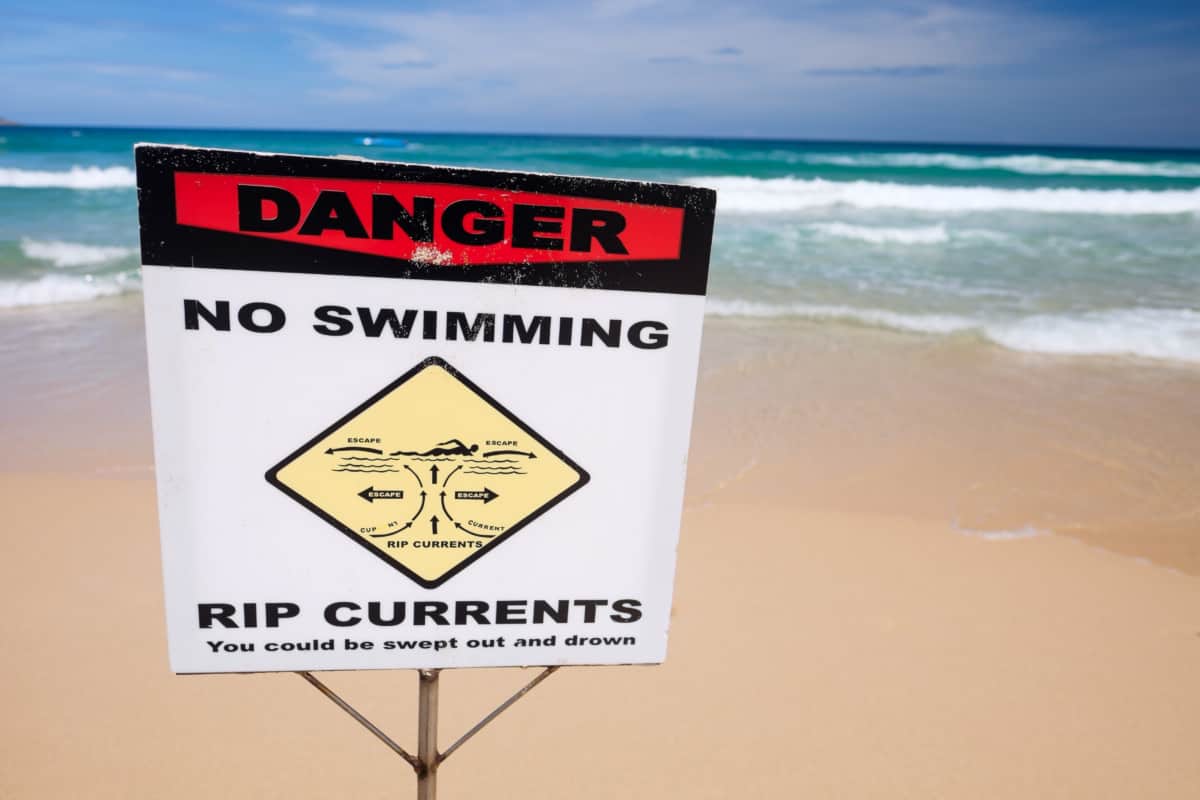The ocean is a fantastic thing, but it’s also a living thing with its quirks and tendencies. When we splash around at the beach or watch our dogs bound into the waves, we can forget that the ocean can be a dangerous and unforgiving thing, and rip currents are just one of its potential threats.
Rip currents are dangerous for surfers, swimmers, and anyone else who gets caught in them. When going into the ocean, surfers and swimmers alike should be adept swimmers and know what rip currents are, how to identify them, and how to survive getting caught in one.
A rip current can be deadly to the unprepared. Before you go into the ocean you should know what rip currents are (and aren’t) and how to deal with them.
What Is a Rip Current?
A rip current is when water that is pushed onshore by waves then forms a channel to run back out to the ocean. Rip currents often appear as darker, calmer areas of water with little to no waves breaking in them. The darker sections of water mask the dangers of the fast-flowing current.
Because the waves do not stop while the water flows out, sometimes, the water flows out in a channel with breaking waves on either side of it. Because there is a great deal of water trying to move out from the beach through a smaller avenue than it used to flow in, it flows fast.
This fast-moving water driving away from the beach is a rip current. It is not the same as a riptide or an undertow, although many people use these terms interchangeably.
For demonstration purposes, this video explains riptides using colors to show the outflow of water:
Usually, rip currents happen in the surf zone (between the beach and the seaward side of the waves and the spot where the waves break and create surf). Since this is almost exclusively the same area people swim and surf in, we have to learn to deal with rip currents, as they are facts of oceangoing.
Why Are Rip Currents Dangerous?
Many people mistakenly believe rip currents will drag you under the water and hold you there long enough to drown you. This belief is incorrect.
Rip currents pose a danger because they can sweep a person far out to sea in a very short time. Even the strongest swimmers can get into trouble with rip currents. People drown from rip currents because they get so tired that they can no longer stay afloat.
Rip currents are unusual. The United States Lifesaving Association (USLA) published a study in 2019 that showed that more than 80% of recorded rescues directly resulted from interactions with rip currents.
that showed that more than 80% of recorded rescues directly resulted from interactions with rip currents.
That means that eight out of every ten times a lifeguard had to go into the water, it was because of a rip current. Not a shark, not because someone knocked themselves out with their surfboard, not because of not waiting 30 minutes before swimming, but because of rip currents, which many beachgoers know nothing about.
Because a rip current is a horizontal current, it doesn’t drag you under but rather away from the safety of the shore. However, because they, along with the inflowing waves, create a closed circuit, as long as a swimmer doesn’t panic or do the wrong things, he will eventually be returned to the shore.
The National Ocean Service estimates that more than 100 people die in the USA every year due to rip currents. The Surf Life Saving
estimates that more than 100 people die in the USA every year due to rip currents. The Surf Life Saving association in Australia states that, on average, 21 people die from rip current related incidents every year.
association in Australia states that, on average, 21 people die from rip current related incidents every year.
What Rip Currents Are Not
Knowing what a riptide is can help keep surfers and swimmers safe. Along those lines, we need to understand many things about water and how it works and flows. Knowing terminology– correct terminology– helps us in that vein.
- A rip current is not a riptide. A riptide can only occur in an inlet or other spot where water flows out during ebb tide through a small channel. It can be stronger than a rip current and can actually sweep a person or object farther out to sea.
- A rip current is not an undertow. Undertow happens anywhere there are breaking waves. The waves bring water in, and that water flows back out beneath the next waves coming in. Undertow can feel like it’s pulling you under, but it’s only dangerous for small children. It also only lasts as long as it takes to reach the next wave.
How Can I Tell If a Rip Current Is Approaching?
While you cannot always see a rip current, they sometimes manifest physical attributes, so it pays to look for them even if you don’t see every single rip current out there.
You can tell if a rip current is approaching based on the following characteristics:
- A break in the pattern of incoming waves
- An area having a notable difference in water color
- Foam, seaweed, or other debris moving steadily out to sea
- Churning water running against the shore and between waves
- Dark, calm spots in the water
Seeing one or more of these can indicate the presence of a rip current, but for safety’s sake, it can’t be overstated that a rip current may be present without causing any of these things. It takes experience to see them, another truth that makes rip currents dangerous to the uninitiated.
Also, note that rip currents are most dangerous around low tide because they tend to flow the fastest.
Before You Go Out
Even seasoned beachgoers need to heed a few guidelines before hitting the water. If you’re new to splashing in the sea, these are even more important for you to know.
- Never go into the ocean alone. This includes that solo sunrise surf. Going without a buddy is plain dangerous. If you’re a new or beginner surfer, make sure you’ve got a partner nearby that can offer assistance, if needed.
- Heed the flags if they’re there. Those colorful beach flags are not for decoration.
- Swim at a beach with a lifeguard. You won’t always find one, especially if you’re looking for that secret spot with the great waves, but if you have a choice, choose the beach with a lifeguard stand.
- Pay attention to those lifeguards. They aren’t shouting instructions to ruin your beach trip. It’s also vital to stay within the safe zones marked on the beach and adhere to the lifeguards’ instructions if they ask you to get out of the water temporarily.
- In the absence of a lifeguard, be extra careful. If you’re not sure about the conditions, stay on the sand. Many popular beaches and surfing areas will have their lifeguards’ hours posted before entering. This enables you to plan your time at the beach accordingly, while knowing a lifeguard will be on duty.
- If someone’s in trouble, don’t just sit there. Get a lifeguard’s attention, call 911, or try to get them a flotation device.
- Don’t die trying to help. Keep in mind that a lot of drowning victims became such by trying to help someone in trouble.
What Do I Do If I Get Caught in a Rip Current?
Once you’ve realized you’re caught in a rip current, you should:
- Remain calm to conserve your energy.
- Avoid fighting the rip current.
- Swim along the shoreline.
- Swim toward the shore after you’re out of the rip current.
- Wave your arms and call for help.
Do not go into the ocean if you cannot swim. The sea is not the place to learn this skill. Rip currents or not, the sea often appears deceptively calm, and almost everyone underestimates the power of flowing water.
Unless you’re surfing and looking for the big waves, most people should stay out of the ocean when the waves are big. Those powerful breakers can be dangerous.
Before going in, do your best to identify whether there is a rip current. As per the information above, this is not foolproof, but it would be foolish not to at least try to identify what’s out there before you grab your board and paddle out.
If you’ve done all the right things, you still might find yourself in the rip’s grip. Above all, do not panic. If you’ve ever seen or tried to rescue a struggling swimmer, you know that panicking is among the very worst things you can do.
Conclusion
The ocean is a powerful thing. Inexperienced swimmers can get in trouble quickly and any swimmer can get in a dangerous situation when rip currents are involved. It’s possible to recognize rip currents, but you will not always be able to do so.
Avoid them when you can, but if you find yourself getting pulled away from the shore by one of them, don’t fight it. Keep your wits about you, swim along the shoreline until you’re free of the rip current, and only then should you expend the energy to swim back.

